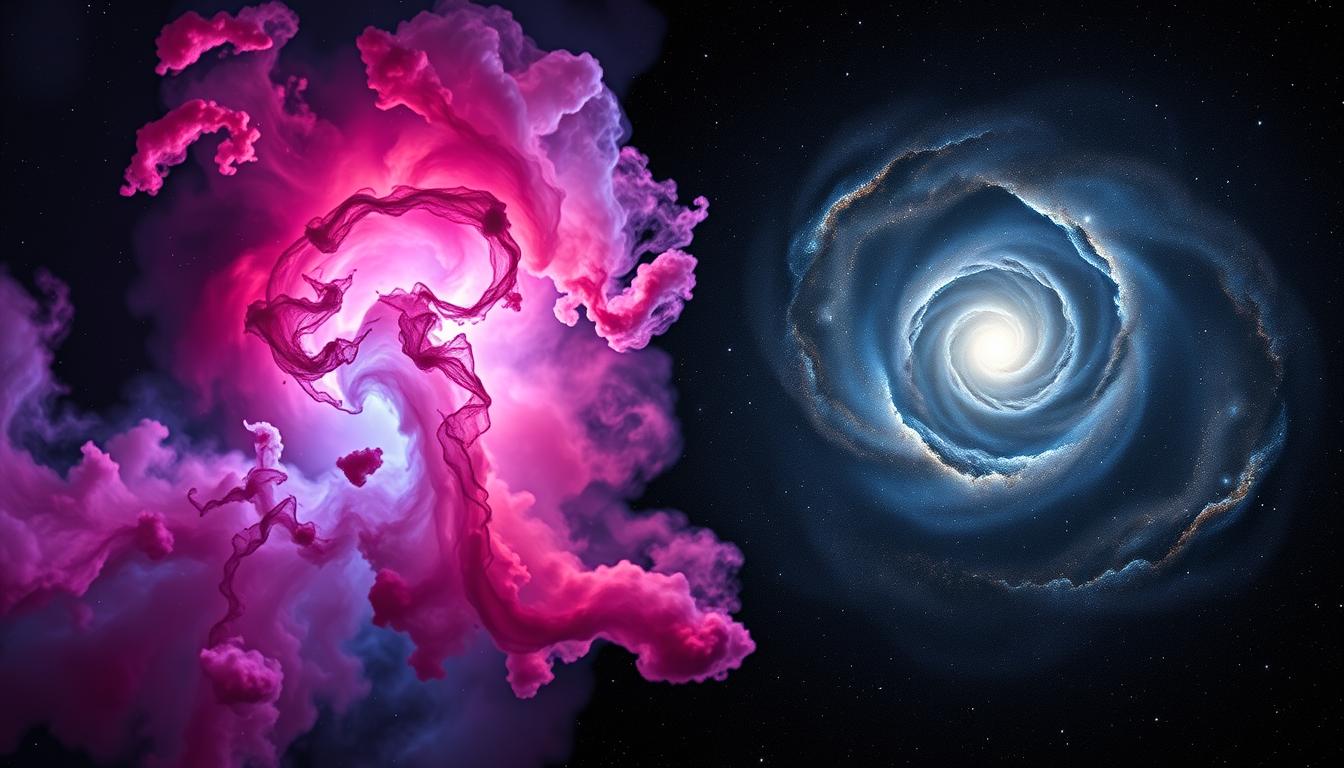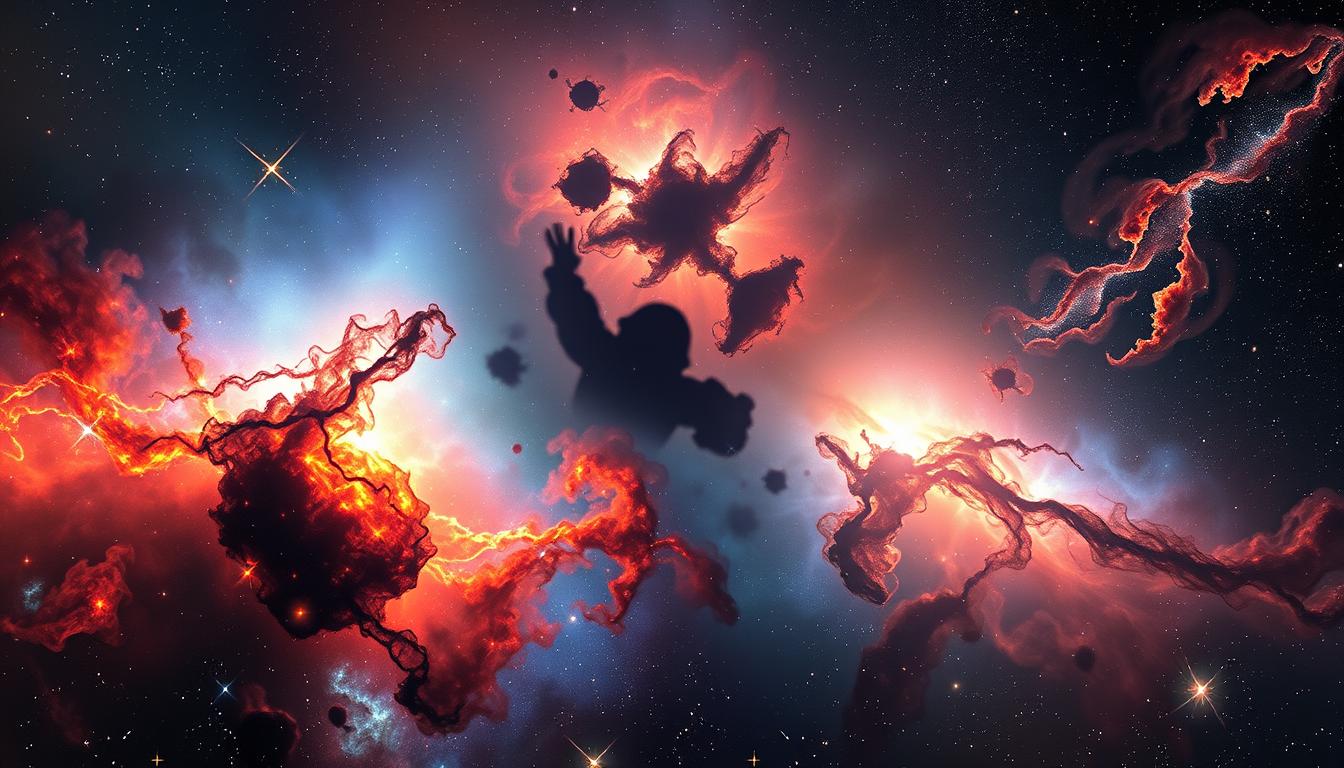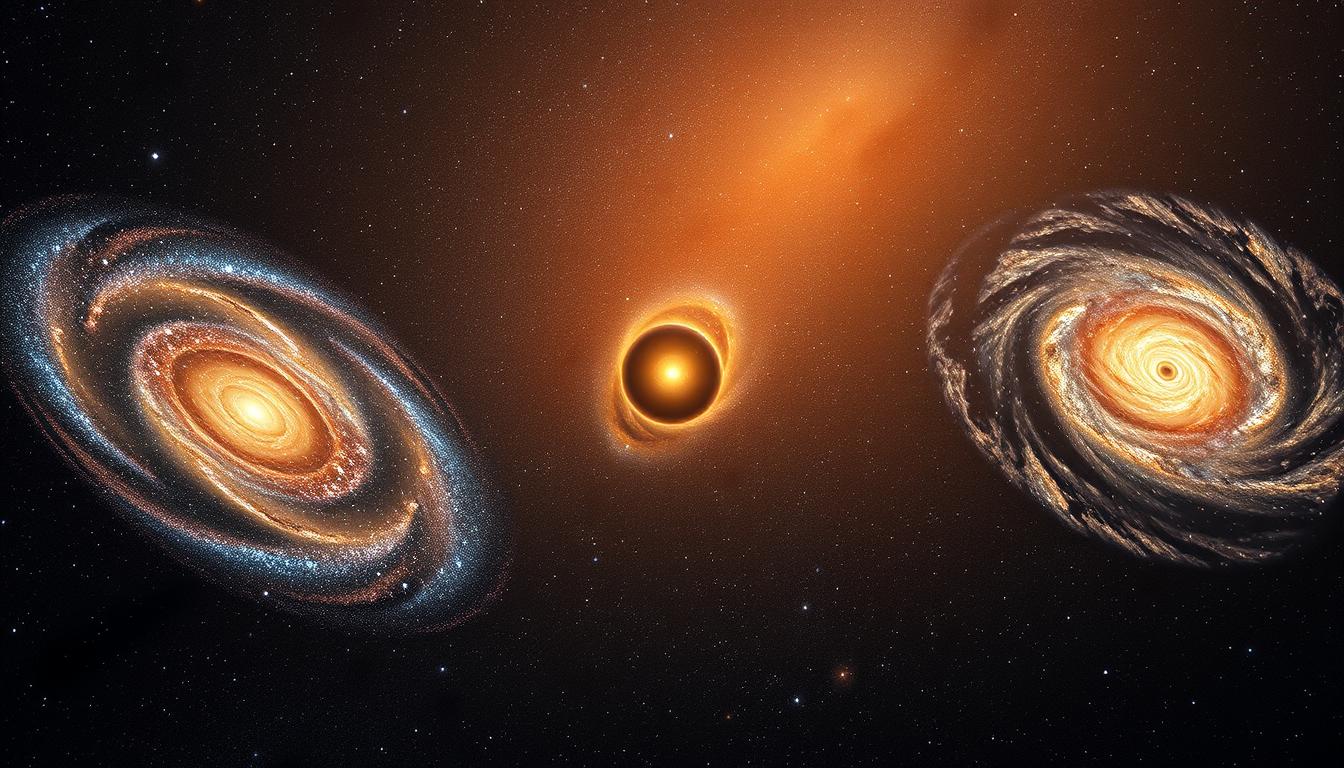The Milky Way galaxy has somewhere around a few hundred billion stars. Some of those are stars like our Sun, and those stars die. When they die, they leave behind a glowing cloud, which we call a nebula. Essentially, a nebula is inside a galaxy and holds those nebulae plus billions of other things like black holes, stars, and planets. You may understand that nebula and galaxy are two different things from this fact.
But if you are not into astronomy, it’s normal to confuse them or not know the difference between a nebula and galaxy. The differences are quite a lot, but they look alike to the naked eye without a telescope! You may see both when you look at the night sky (outside of a city) and not even realize they are different things.
Nebulae (plural for nebula) are vast clouds of gas and dust, often called “stellar nurseries” because stars are born there. Sometimes these nebulae shine because nearby stars light them up. Galaxies, on the other hand, are like cosmic cities. They contain billions of stars, planets, and even black holes (also many nebulae). Our home, the Milky Way, is 200,000 light-years across. That’s 33,000 times wider than the Helix Nebula!
It’s easier to spot a nebula than a Galaxy, though. They are much farther apart. The closest galaxy to us is the Andromeda Galaxy at 2.5 million light-years away. Helix Nebula, the closest nebula, is only 650 light-years away. It’s important to understand nebula and galaxy – know the differences between them. Let’s see what those are.

Nebula vs. Galaxy: Quick Snapshot
Quick fact: a single nebula might be a few dozen light‑years across, while a galaxy stretches tens of thousands to hundreds of thousands of light‑years. That jump in scale puts everything into perspective. A nebula is a cloud of gas and dust. It can glow, hide, or drift quietly. A galaxy is a huge system that holds those clouds, billions of stars, planets, black holes, dark matter, and practically everything in the universe.
Think of a nebula as a workshop and a galaxy as the whole city. The workshop builds stars. The city houses the workshops, the workers, and the rules that keep the place together. Nebulae are local, colorful, and often short‑lived. Galaxies are vast, structured, and last for billions of years.
What is a Nebula?
Picture a cloud in the universe, just floating around and looking beautiful. That’s a nebula and stars born inside. It’s just a vast cloud of gas and dust, nothing more. It has several types, though, and each behaves, looks, and acts differently. Some, like the planetary nebulae, form when dying stars shed their outer layers. The emission nebula glows strongly because nearby hot stars send out strong light that ionizes the gas. Some are thick with dust and appear as dark patches that block the stars behind them.
Despite their dramatic images, nebulae are very thin compared to Earth’s atmosphere. Even the densest parts are an extreme vacuum by our standards. Still, they matter because they contain the raw elements—carbon, oxygen, iron—that later become planets and, maybe, life.
What is a Galaxy?
Galaxies are the universe’s metropolises. They are a massive system of stars, gas, dust, and dark matter held together by gravity. Think of billions of stars moving in patterns. Many galaxies have shapes: spirals with arms, rounded ellipticals, or messy irregulars. Inside them are star clusters, black holes, and countless nebulae.
The Milky Way, our home, hosts over 100 billion planets and a supermassive black hole. Unlike nebulae, galaxies evolve over eons. They control how gas flows, where stars form, and how chemical elements spread. Galaxies collide and merge. Those interactions can spark new waves of star formation or strip a galaxy of its gas. The core thing that keeps a galaxy together is the dark matter in and around it. They are very complex structures compared to nebulae.

Types of Nebulae and Galaxy
Like I mentioned before, nebulae and galaxies come in types. Not every nebula glows. Not every galaxy has spiral arms. Knowing different types of a nebula and galaxy could help you read them better with or without a telescope. Think of each type as a tag on the box: what’s inside, how active it is, and what to expect in a telescope.
Here’s the big idea when you hear nebula and galaxy together: nebula types are about gas behavior and the star life cycle. They track what gas is doing and what stage a star is in. Galaxy types are about structure and how whole star populations evolve. They track shape, star ages, and gas supply. One is about local physics in a cloud. The other is about the architecture of a star city.
Nebulae
- Emission nebulae. Gas glows. Hot, young stars flood it with energy. Often red in images. Think of these as cosmic neon signs. Ionized hydrogen gas glows under UV radiation from young stars. The Orion Nebula is a great example.
- Reflection nebulae. Dust scatters light. Usually looks bluish or pale. These act like celestial mirrors. When the dust scatters the light, it creates that blue haze similar to fog reflecting car headlights. M78 in Orion is one of these.
- Dark nebulae. Thick dust blocks light. Shows up as black lanes or patches. These shadowy giants block light, hiding protostars within them. The Horsehead Nebula is one of these. No glow, nothing. Just secrets.
- Planetary nebulae. Has nothing to do with planets. Dying sun-like stars shed shells and leave a dense white dwarf. In 5 billion years, our Sun will create one. It will become a planetary nebula. They are small, round, and often bright.
Galaxies
- Spiral. Disk with arms and a central bulge. Picture a spiral galaxy as a stellar assembly line. Its arms, rich in gas and cosmic dust, create new stars. The Milky Way is a barred spiral, with a central “bar” funneling material inward to fuel star birth.
- Elliptical. These smooth, egg-shaped giants are like retirement communities for stars. They are full of ancient stars and little interstellar gas. They’re quiet but massive. M87, an elliptical galaxy, hosts a supermassive black hole 7,000 times heavier than our Sun.
- Irregular. They are chaotic and rare; they have no set shape. Collisions in the universe make these galaxies, there is no rule as to how they are formed, they just form. Often stirred by gravity or past collisions.
- Dwarf — Small, faint cousins. Can be any of the above in miniature sizes.
Main Differences of These Types
Nebula types are all about the life cycle of stars. They either make new ones or mark the end of old ones. Their shapes and colors depend on the nearby stars and gas. A glowing red emission nebula points to hot, young stars. A faint blue reflection nebula shows starlight bouncing off dust. A ragged supernova remnant means a star ended in a blast.
Galaxy types are about structure and scale. Spirals often host active star formation in their arms. Ellipticals are older, with little gas left, so not a lot of stars form. Irregular galaxies are messy and often have temporary shapes.

What are Nebula and Galaxy Made of
I gave brief insight about what a nebula and galaxy are made of. It’s not that hard, really. Nebulae are mostly gas and dust. Galaxies have a variety of matter, such as stars, gas, dust, and dark matter. The proportions, though, are important. Sometimes, the amount of matter in a galaxy could shape it. Same with nebula. It determines how they behave and how long they live.
Nebulae are made of: gas, dust, and molecules
In the making of stars, hydrogen is the main fuel. Hydrogen gas pushes and creates new stars. This gas can be ionized and glowing or cold and molecular. It’s not hard to understand why and how nebulae are mostly hydrogen gas and dust. The interesting thing, though, is that the dust grains are made of tiny bits of carbon, silicon, and ice. These dust grains block and scatter the light. That’s why some nebulae are dark (dark nebulae) and some glow. In the densest areas, molecules like H2 form, and the cloud can cool. Cooler clouds can collapse under gravity and form stars and planetary disks.
Nebulae also carry heavier elements made by older stars. Things like carbon, oxygen, and iron. Even though a nebula looks thick in photos, its density is tiny compared to any atmosphere on Earth. The important fact is that nebulae concentrate the raw materials in small volumes, which lets gravity do its job.
Galaxies have: stars, gas, dust, dark matter
Galaxies are loaded with stars. The visible mass is mostly in stars. However, galaxies also host gas and dust between those stars that feed future star formation. Unlike a nebula, the gas is spread thinly across vast distances.
Then there’s dark matter. We can’t see it, but its gravity shapes how galaxies form and rotate. Dark matter holds the galaxy together that visible matter can’t. Galaxies also contain central black holes, star clusters, and streams of gas torn off during interactions. This mix of stars, gas, dust, and dark matter also sets the type of galaxy. Blue and active, or red and sleepy.
Size, Scale, and Numbers: comparing nebula and galaxy
As you may have already understood, nebulae and galaxies are on different scales. This includes their sizes, too. A nebula might stretch a few dozen to a few hundred light-years across. It is big but still local compared to the star cities we call galaxies. A galaxy is way bigger. Tens of thousands to hundreds of thousands of light-years across.
Typical sizes and distances
Nebulae typically range from a few light-years (planetary nebulae) to over a hundred light-years (giant molecular clouds). They usually live inside galaxies, scattered along spiral arms or clustered in star-forming regions. The closest bright nebulae, like Orion, sit just a few hundred to a thousand light-years from us.
Galaxies, as you can imagine, have a few hundred million nebulae inside. You can do the math. To put it in numbers, even a small galaxy is thousands of light-years across. The Milky Way is about 100,000 light-years across. The Andromeda Galaxy is even bigger, and it’s still considered just one member of our local group. Most galaxies we see in telescopes are millions of light-years away. Distances here are enormous.
A Nebula and Galaxy in the Night Sky: How Do Astronomers Observe Them
All the pretty photos you see of nebulae and galaxies are not how they really look. When you use a basic telescope or an advanced one, you won’t be able to see them as they are in the pictures. A fuzzy patch might be a nearby cloud or a distant island of stars. Astronomers don’t guess. They test. They split light into pieces, look at many wavelengths, check how things move, and compare shapes. Those clues show whether you’re seeing a local nebula or a whole galaxy.
Telescopes and Wavelengths (visible, infrared, radio)
Different telescopes act like different senses. Visible light shows glowing gas, dust lanes, and starlight. Infrared cuts through dust and helps show us the stars inside a nebula. Radio maps cold gas and big molecular clouds where stars will form. X-rays and ultraviolet pick up hot gas and shock fronts from explosions.
A nebula often lights up in a few narrow colors. They are specific emission lines from hydrogen or oxygen. That makes it stand out in visible images. A galaxy’s light is a blended glow of millions of stars, so its spectrum looks broad and smooth. Infrared can reveal a dusty galaxy core, or it can show the warm baby stars tucked inside a nebula; context matters.
Image clues: structure, brightness, star density
When you look at a nebula or galaxy with naked eye, you can detect some simple things to understand which one it is. Nebulae tend to have ragged edges, wisps, filaments, and bright knots where stars heat gas. They can show dark lanes where dust blocks light.
Galaxies are large-scale structures. Spirals have arms and a central bulge. Ellipticals look smooth. Even messy irregulars show many tiny, resolved stars when they’re close. Star density is the giveaway: a galaxy’s light comes from billions of stars spread across a disk or halo, so the image often looks grainy or smoothly glowing at large scale. A nebula’s light is local and patchy. If you are very lucky and at a very remote place, you may be able to see the Milky Way’s arms or even Andromeda with a solid telescope. Milky Way’s arms are very bright and easy to detect because we are close to it.
Conclusion
A nebula and galaxy are two very different things. If you are new to astronomy and cosmology, especially if you like to observe things with a telescope, you may confuse them a lot. Essentially, a nebula is a dust cloud where stars are born. Compared to galaxies, they are way smaller, and galaxies have a bunch of nebulae inside them. Galaxies are made up of matter, and they have stars, planets, and all kinds of cosmological stuff inside them. Dark matter and dark energy keep them together. With nebulae, that’s not really it. Gas and dust make them, and they stay together. Both have different varieties, and each type has a different lifespan, results, and other things.
It’s easier to see galaxies with the naked eye, but it’s not easy to see nebulae. They look beautiful in pictures because we use infrared light to make them in colors that we humans can see. In the end, a nebula and galaxy are not the same thing. Everything about them is different.
FAQ
What’s the main difference between a nebula and a galaxy?
A nebula is a cloud of gas and dust where stars form, while a galaxy is a massive collection of stars, planets, and other cosmic matter bound by gravity. Think of a nebula as a “stellar nursery” inside a galaxy.
Can you see nebulae and galaxies with the naked eye?
Yes! The Orion Nebula and the Andromeda Galaxy are visible under dark skies. Binoculars or a telescope will reveal more detail, like the glowing gas in nebulae or the spiral arms of galaxies.
How do planetary nebulae form?
When a dying star sheds its outer layers, it creates a glowing shell of gas called a planetary nebula. The remaining core becomes a white dwarf, like the Helix Nebula’s central star.
What’s inside dark nebulae?
These dense clouds block light from stars behind them, hiding new star-forming regions. The Horsehead Nebula is a famous example—its dark dust creates striking silhouettes against glowing gas.
How far away are the nearest galaxies?
The Andromeda Galaxy, our closest spiral neighbor, is 2.5 million light-years away. Dwarf galaxies like the Large Magellanic Cloud orbit the Milky Way at about 160,000 light-years.